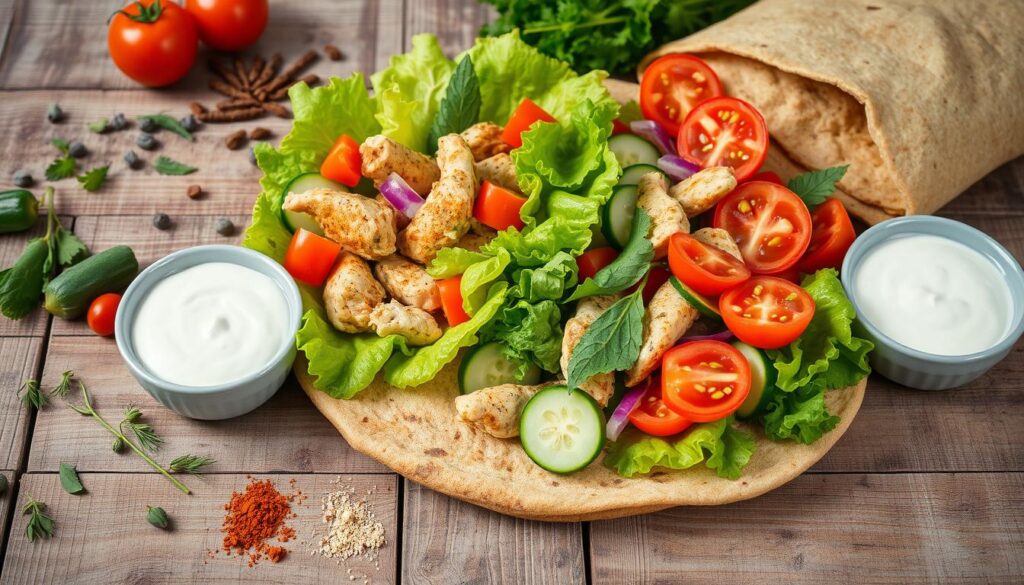Shawarma is a favorite in Middle Eastern cuisine. But is it a healthy choice? Let’s look at its nutritional profile and the good and bad sides of this tasty dish.
Shawarma can be made in many ways, with different meats, veggies, and spices. It usually has pita bread, roasted meat, and fresh toppings like tomatoes and onions. While it’s nutritious, knowing its health effects is key.
Key Takeaways
- Shawarma can be a good source of protein, fiber, and nutrients with lean meats and veggies.
- But, it’s high in calories, fat, and sodium, which can be a problem if eaten too much.
- Making shawarma at home or choosing healthier options at fast-food places can help.
- Adding shawarma to a balanced diet and exercise can make for a healthy meal.
- People with certain diets or health issues should be careful with shawarma.
Understanding Shawarma: A Brief Overview
Shawarma is a favorite dish from the Middle East that’s loved worldwide. It started in the Ottoman Empire in the 18th century. It’s made with marinated meat like chicken, beef, lamb, or turkey, roasted on a vertical spit.
The meat is then shaved off and served in pita or flatbread. It comes with fresh veggies, tasty sauces, and spices.
What is Shawarma?
Shawarma is about cooking meat on a vertical spit. Thin slices of meat are stacked and slowly turned in front of heat. This makes the meat juicy and flavorful.
The dish is a key part of Middle Eastern cuisine.
Origin and Cultural Significance
Shawarma’s roots are in the Ottoman Empire, where it was called “çevirme,” meaning “to turn.” It’s a twist on Turkish döner kebab. As people moved, shawarma became a popular street food.
“Shawarma is not just a dish, it’s a cultural experience that brings people together, sharing the flavors of the Middle East.”
Nutritional Profile of Shawarma
Shawarma is a favorite Middle Eastern dish, loved for its tasty flavors and special cooking method. It’s important to know about its nutritional value. A typical shawarma wrap has about 460 calories, 20g of fat, 7.2g of saturated fat, 35g of protein, 40g of carbs, 1000mg of sodium, and 5g of fiber.
Breakdown of Ingredients
The ingredients in shawarma greatly affect its nutritional content. For example, 60g of pita bread has 165 calories. Meanwhile, 30g of hummus adds 50 calories. A 100g serving of chicken has 142 calories, and a medium tomato adds 23 calories.
Also, 100g of lettuce has just 15 calories. But, 110g of french fries have 365 calories.
Healthier Options Available
- Choose lean meats like chicken or turkey to cut down on fat and calories.
- Go for whole-grain pita or wraps to increase fiber and nutrients.
- Add lots of fresh veggies like tomatoes, lettuce, and cucumbers for more vitamins and minerals.
- Steer clear of heavy sauces and dressings. Instead, use lighter yogurt or tahini-based ones.
- Try vegetarian or vegan shawarma with falafel or seitan for a healthier option.
By paying attention to ingredients and cooking methods, you can enjoy shawarma’s great taste while keeping your diet balanced. Remember, eating too much shawarma can lead to weight gain and health issues due to its high fat, sodium, and calorie content.
Health Benefits of Eating Shawarma
Shawarma is a tasty Middle Eastern dish that’s good for you too. It’s packed with protein, which helps muscles grow and repair. It also has calcium, magnesium, iron, vitamin A, and vitamin C.
The spices in shawarma, like turmeric and cumin, fight inflammation and protect against free radicals. The fresh veggies in it add vitamins, minerals, and fiber. This makes shawarma great for your health.
Choosing the right ingredients can make shawarma a healthy meal. Use lean proteins, whole-grain wraps, and lots of veggies. This way, you can enjoy its delicious taste while staying healthy.
Rich Source of Protein
Shawarma has about 35 grams of protein per serving. This is great for building and repairing muscles. It also keeps you full, helping with diet and weight control.
Contains Essential Nutrients
Shawarma is full of important nutrients like calcium and vitamins A and C. These help with bone health and the immune system. It’s a well-rounded dish for your body.

When prepared with a focus on nutrition, shawarma can be a nutritious and satisfying option for your meals.
Caloric Content and Portion Sizes
Shawarma’s calories can change a lot based on serving size and toppings. A standard wrap has about 450 calories. It has 40 grams of carbs, 30-35 grams of protein, 4-5 grams of fiber, and 20 grams of fat. Plus, it has 1,000 milligrams of sodium.
A typical serving size is 270-280 grams. It has 460 calories, 20 grams of fat, 7.2 grams of saturated fat, 35 grams of protein, 40 grams of carbs, 1,000 milligrams of sodium, and 5 grams of fiber.
Average Caloric Intake per Serving
The calories in shawarma can vary a lot. A standard serving has about 450 calories. But, it can be between 300 to 600 calories. This depends on the meat, sauces, toppings, and portion size.
Tips for Managing Portions
- Sharing a full-sized shawarma with someone can cut your calories in half.
- Try a “mini” or “half” size shawarma for less calories but still great taste.
- Add more veggies and less high-calorie sauces or toppings to your shawarma.
- Listen to your body and stop eating when you’re full, not when you’ve eaten everything.
Being smart about portion sizes can help you enjoy shawarma without overdoing it. This way, you can add it to a healthy diet.
Shawarma Variations: Which is Healthiest?
Choosing the right protein is key to a healthy shawarma recipe. Traditional shawarma often uses lamb or beef. But, chicken and turkey are leaner options.
Chicken vs. Beef vs. Lamb
Chicken or turkey shawarma is the healthiest choice. These meats have less saturated fat and calories than beef or lamb. A chicken shawarma recipe offers lean protein without too many calories or fats.
Beef and lamb shawarma taste richer but have more saturated fat and cholesterol. If you want traditional shawarma but care about health, try chicken or turkey.
Vegetarian Shawarma Options
For a vegan shawarma or vegetarian diet, there are tasty meat-free options. Falafel, seitan, and soy curls are great plant-based proteins. They can be seasoned to taste like real shawarma.
These vegetarian shawarma choices are good for those with dietary restrictions. They’re also lower in saturated fats and calories, making them a healthier option.
The healthiest shawarma depends on your diet and preferences. Look at the protein, fat, and nutrition to find a shawarma that fits your health goals and tastes great.
Shawarma and Dietary Restrictions
Shawarma is tasty and can fit many diets. You can find gluten-free, vegetarian, or vegan options. This makes shawarma great for everyone.
Gluten-Free Shawarma
Gluten-free shawarma is a tasty choice. Chicken shawarma is often gluten-free. You can serve it without wheat wraps for a gluten-free meal.
Or, try lettuce wraps or gluten-free pita bread. This way, you can enjoy shawarma while sticking to your diet.
Vegetarian and Vegan Shawarma
Vegans and vegetarians can enjoy shawarma too. Many places now offer vegan and vegetarian options. You can get falafel, seitan, or grilled veggies.
These options are just as tasty as the meat ones. They’re also full of fiber and less fat.
When you go to a shawarma place, ask about their special options. This way, you can find the perfect fit for your shawarma diet and lifestyle.
Potential Health Concerns of Shawarma
Shawarma is tasty and popular, but it comes with health risks. High sodium levels in many shawarma dishes are a big concern. Some servings have up to 1000mg of sodium, which can be bad for people with high blood pressure or heart issues.
Some shawarma may also have additives and preservatives, especially in commercial places. These can lower the dish’s nutritional value and pose health risks if eaten too much.
Food Safety Risks
Shawarma can cause foodborne illnesses if not made and handled right. Bad handling, storage, or cooking can lead to bacterial contamination. This can cause salmonella or E. coli infections. Sadly, some cases of food poisoning from shawarma have even been fatal.
The high fat content in shawarma, from fatty meats and oils, can lead to weight gain and high cholesterol. This is a big problem for people watching their diet or with heart health concerns.
To lower the health risks of shawarma, choose healthier options. Use leaner proteins, less oil and preservatives, and follow good food handling and storage. This way, you can still enjoy shawarma without worrying too much about health concerns.
Shawarma in a Balanced Diet
Shawarma, a favorite Middle Eastern dish, can be part of a healthy diet if eaten in moderation. It’s all about making smart choices to make your shawarma healthier.
Incorporating Shawarma into Your Meals
Have shawarma just once a week. Pair it with lots of fresh, colorful veggies. Choose lean proteins like chicken or turkey, which are less fatty than beef or lamb. Use whole wheat pita or tortillas for more fiber and nutrients.
Pairing Shawarma with Healthy Sides
- Enjoy your shawarma with a side salad full of greens, tomatoes, cucumbers, and a light dressing.
- Roasted or grilled veggies like bell peppers, zucchini, and eggplant are great for extra nutrients.
- Replace high-calorie sides like french fries with hummus or baba ghanoush for a better choice.
By making these simple changes, you can enjoy shawarma’s flavors while keeping your diet balanced and healthy.
Enjoying shawarma as part of a healthy lifestyle means eating it in moderation and being mindful. With a few smart choices, you can enjoy this tasty Middle Eastern dish without harming your shawarma diet or health.
Making Homemade Shawarma
When you make healthy shawarma at home, you control what goes into it. Use lean meats, flavorful spices, and grill or roast instead of fry. This way, you can make tasty, nutritious shawarma in your kitchen.
Simple Recipes for Healthy Shawarma
Begin with lean chicken thighs. They stay juicy even when cooked a bit longer. Marinate them in spices like paprika, cumin, and coriander. This gives them a real shawarma taste without extra oil.
For the sauce, choose yogurt or tahini. Make it ahead and store it in a bottle. It’s creamy and tangy, without the calories of mayonnaise.
Use whole grain pita or lettuce wraps for a lower-carb base. Add fresh veggies like tomatoes and cucumbers. They add nutrition and crunch to your healthy shawarma.
Tips for Healthier Cooking Methods
Grill or roast your low-fat shawarma meats instead of frying. An air fryer is also a good choice. It cooks chicken in about 15 minutes per side at 400°F, without too much oil.
Soak rice grains for 15 minutes before cooking. This cuts down cooking time and keeps more nutrients. Adding chickpeas to the rice boosts fiber and protein.
Choose lean proteins, fresh veggies, and healthier cooking methods. This way, you can enjoy shawarma’s great taste while making it healthier and low-fat.

Conclusion: Is Shawarma Right for You?
Weighing the Pros and Cons
Shawarma can be healthy if eaten wisely. It’s packed with protein and nutrients like iron and vitamins. You can also choose what goes into it.
But, it can be high in calories and sodium, especially if it’s from a restaurant. How healthy it is depends on how it’s made, how much you eat, and how often.
Final Thoughts on Shawarma Consumption
Choosing the right ingredients and cooking methods makes shawarma a good choice for a healthy diet. Pick leaner meats and add more veggies. Controlling how much you eat helps too.
Whether shawarma fits into your diet depends on your personal needs and likes. Eating it in small amounts can be tasty and keep you healthy.

